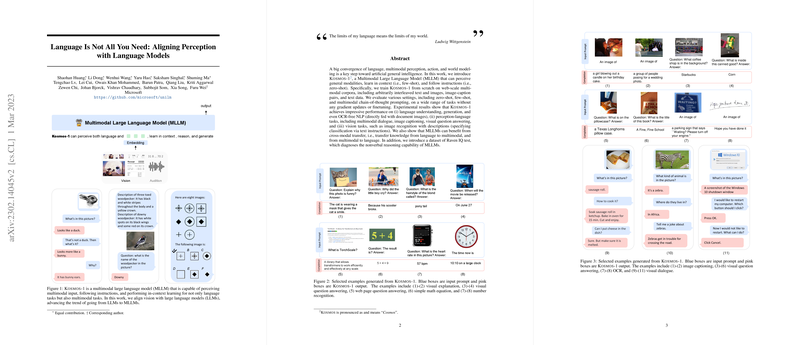Essay on "Language Is Not All You Need: Aligning Perception with LLMs"
The paper "Language Is Not All You Need: Aligning Perception with LLMs" proposes an advancement in artificial intelligence through the integration of multimodal capabilities into LLMs, epitomized by the introduction of JARVIS, a Multimodal LLM (MLLM). This development signifies a shift from standalone LLMs to systems capable of processing and generating responses from a variety of data inputs, including text, images, and other modalities.
The core objective of JARVIS is to unify modalities with LLMs to extend the applications of AI towards achieving artificial general intelligence (AGI). By doing so, JARVIS moves beyond the limitations of current LLMs, which primarily handle text data, and makes headway in domains requiring multimodal sensory integration such as document intelligence, visual question answering, and robotics.
Methodology
JARVIS is trained on web-scale multimodal datasets that include arbitrarily interleaved text and images, forming a comprehensive learning corpus. The model integrates vision encoders with a Transformer-based backbone, which acts as a general-purpose interface. This approach allows JARVIS to process various data types and generate appropriate multimodal outputs in an autoregressive manner.
A distinctive feature of JARVIS is its capacity for few-shot and zero-shot learning, enabling tasks such as visual question answering and image captioning without the need for gradient updates or fine-tuning. This capability is pivotal for the model’s application in diverse and dynamically changing environments where training data may not be available or exhaustive.
Key Results
The empirical evaluations demonstrate JARVIS's efficacy in several domains:
- Language and Multimodal Tasks: JARVIS showcased strong performance across multiple tasks, rivaling and in some cases surpassing existing benchmarks. Specifically, JARVIS demonstrated impressive command in visual question answering and image captioning, reported through competitive CIDEr and VQA scores, outperforming previous models such as Flamingo in certain tasks despite having a smaller computational footprint.
- Cross-Modal Transfer Learning: A significant contribution is the demonstrated capability of knowledge transfer between modalities. Experiments revealed that JARVIS can transfer learned instruction-following capabilities from language-based tasks to multimodal scenarios, enhancing its reasoning and perceptual acuity.
- Nonverbal Reasoning: The introduction of a Raven IQ test dataset further established JARVIS's potential in non-traditional AI domains such as nonverbal reasoning. The model's capability to tackle Raven's Progressive Matrices shows JARVIS's ability to generalize and reason abstractly, though there remains a gap compared to human-level performance.
- Instruction Tuning and Transferability: Notably, JARVIS benefits from language-only instruction tuning, enhancing multimodal task performance—an assertion confirmed across numerous benchmarks, underscoring the importance of cross-modal learning pathways.
Implications and Future Direction
The implications of this research are manifold. JARVIS exemplifies the convergence of AI modalities into a cohesive framework, harnessing diverse data channels to tackle complex, real-world problems. These advancements could lead to significant impacts in fields demanding comprehensive perception capabilities, including automated visual inspections, autonomous navigation systems, and more intuitive human-computer interactions.
In future research, scaling up JARVIS and including other modalities, such as audio, could further bridge the gap toward AGI. Expanding the model's ability to perform zero-shot learning in more complex and esoteric tasks remains a vigorous research avenue. Moreover, integrating JARVIS as a component of larger multimodal systems could lead to innovative applications, particularly in domains integrating robotics and AI-enhanced user interfaces.
In conclusion, the work presented on JARVIS sets a robust foundational framework for future advancements in multimodal AI, demonstrating that LLMs enriched with perceptual skills can significantly broaden the scope and depth of applications AI systems can address, steering the community ever closer to the ambitious vision of AGI.
